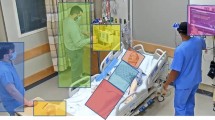Abstract
The manipulation of extracorporeal circulation (ECC), which is performed by perfusionists during cardiovascular surgery, is a highly sophisticated cognitive process based on visual information obtained from information sources such as ECC indicators, surgeons, an operating field, a scrub nurse, surgical instruments, displays, patients, among others. An eye-tracking approach is expected to be a powerful means of automatic and rapid analysis. This paper presents the results of a pilot study in which an eye-tracking approach was applied to the analysis of ECC operation tasks conducted during real clinical cardiovascular surgery in the operating room. Eye-tracking data on four perfusionists were recorded while they were manipulating the ECC during a series of cardiovascular surgeries. The experience of the perfusionists ranged from 2 to 26+ years. Based on the data obtained, fixation-by-fixation cataloging of eye-tracking data in which each fixation was transcribed in timeline style was performed for each perfusionist. Gaze allocation tendencies during the surgeries for all four perfusionists were determined through a comparative analysis. It was noted that an expert engineer dispersed his attention more widely than did intermediate and novice perfusionists. Taking the results of the data analysis into consideration, we discuss the implications of well-skilled perfusionists’ performance during the manipulation of ECC, as well as the principles that guide how eye-tracking data obtained in real surgery should be processed. This is the first study on the application of an eye-tracking approach to the analysis of ECC operation tasks to be reported in the Japanese literature








Similar content being viewed by others

References
Sawa Y, Tatsumi E, Funakubo A, Horiuchi T, Iwasaki K, Kishida A, Masuzawa T, Matsuda K, Myoui A, Nishimura M, Nishimura T, Tokunaga S, Tomizawa Y, Tomo T, Tsukiya T, Yamaoka T. Journal of Artificial Organs 2010: the year in review. J Artif Organs. 2011;14:1–8.
Tomizawa Y, Momose N, Matayoshi T. Extracorporeal circulation technical training DVD volume 1: basic operation and troubleshooting scenarios. J Artif Organs. 2009;12:278–82.
Stoney WS, Alford WC Jr, Burrus GR. Air embolism and other accidents using pump oxygenators. Ann Thorac Surg. 1980;29:336–40.
Aoki H, Itoh K, Tomizawa Y, Matayoshi T, Yozu R. Application of eye tracking approach to medical domain: eye-tracking analysis of skilled performance in pump-oxygenator artificial heart-lung machine operation. Presented at the 15th European Conf on Eye Movement; 2009.
Krupinski EA, Roehrig H. Pulmonary nodule detection and visual search: P45 and P104 monochrome versus color monitor displays. Acad Radiol. 2002;9:638–45.
Law B, Atkins MS, Kirkpatrick AE, Lomax AJ. Eye gaze patterns differentiate novice and experts in a virtual laparoscopic surgery training environment. In: Proc Eye Tracking Research and Application Symp 2004. New York: ACM Press; 2004. p. 41–8.
Mello-Thoms C, Dunn S, Nodine CF, Kundel HL, Weinstein SP. The perception of breast cancer: what differentiates missed from reported cancers in mammography? Acad Radiol. 2002;9:1004–12.
Segall N, Taekman JM, Mark JB, Hobbs G, Wright MC. Coding and visualizing eye tracking data in simulated anesthesia care. In: Proc 2007 Human Factors and Ergonomics Society Annual Meeting. Human Factors and Ergonomics Society; 2007. p. 765–9.
Tchalenko J, Dempere-Marco L, Hu XP, Yang GZ. Quantitative analysis of eye control in surgical skill assessment. Presented at the 11th European Conf on Eye Movements; 2001.
Aoki H, Suzuki S. Gaze metrics for efficient and safe operations of hemodialysis. In: Proc 7th Int Conf Methods and Techniques in Behavioral Research; 2010. p. 200–3.
Seagull FJ, Xiao Y, MacKenzie CF, Jaberi M, Dutton RP. Monitoring behavior: a pilot study using an ambulatory eye-tracker in surgical operating rooms. In: Proc 1999 Human Factors and Ergonomics Society Annu Meet. Human Factors and Ergonomics Society; 1999. p. 850–4.
Rayner K. Eye movements in reading and information processing: 20 years of research. Psychol Bull. 1998;124:372–422.
Acknowledgments
This research was partly supported by a Grant-in-Aid for Encouragement of Young Scientists (B) (No. 22710137) from the Japan Society for the Promotion of Science. We also acknowledge Prof. Kenji Itoh for his insightful suggestions to our research and Yoko Zenke for her great effort in the data analysis.
Author information
Authors and Affiliations
Corresponding authors
Rights and permissions
About this article
Cite this article
Tomizawa, Y., Aoki, H., Suzuki, S. et al. Eye-tracking analysis of skilled performance in clinical extracorporeal circulation. J Artif Organs 15, 146–157 (2012). https://doi.org/10.1007/s10047-012-0630-z
Received:
Accepted:
Published:
Issue Date:
DOI: https://doi.org/10.1007/s10047-012-0630-z



